Pacific Salmon Bycatch Overview
Bycatch is defined in the Magnuson-Stevens Fishery Conservation and Management Act as fish that are harvested in a fishery but which are not sold or kept for personal use. This includes the portion of the catch that is discarded back into the sea and unobserved mortality due to a direct encounter with fishing gear that does not result in the capture of that species by a fisherman. Discards include species that must be returned to the sea by law (regulatory discards), and fish that are discarded at the discretion of the fisherman because they are not economically worthwhile to keep (economic discards). Although fishermen try to catch only fish that can be sold, fishing gear is not 100% selective, and some undesirable fish and other organisms are caught incidentally in the course of fishing operations.
These non-target organisms are considered bycatch. The Council works to balance the priorities of all of the national standards in the MSA, one of which states that conservation and management measures shall, to the extent practicable, minimize bycatch, and to the extent bycatch cannot be avoided, minimize the mortality of such bycatch.
Salmon are caught incidentally in the Bering Sea and Aleutian Islands (BSAI) offshore trawl fisheries, especially in the pollock pelagic trawl fishery. Salmon are considered a prohibited species catch (PSC) in groundfish fisheries, and cannot be retained for sale. Nearly all salmon taken as bycatch are Chinook salmon and chum salmon.
Salmon Bycatch Amounts and Origin
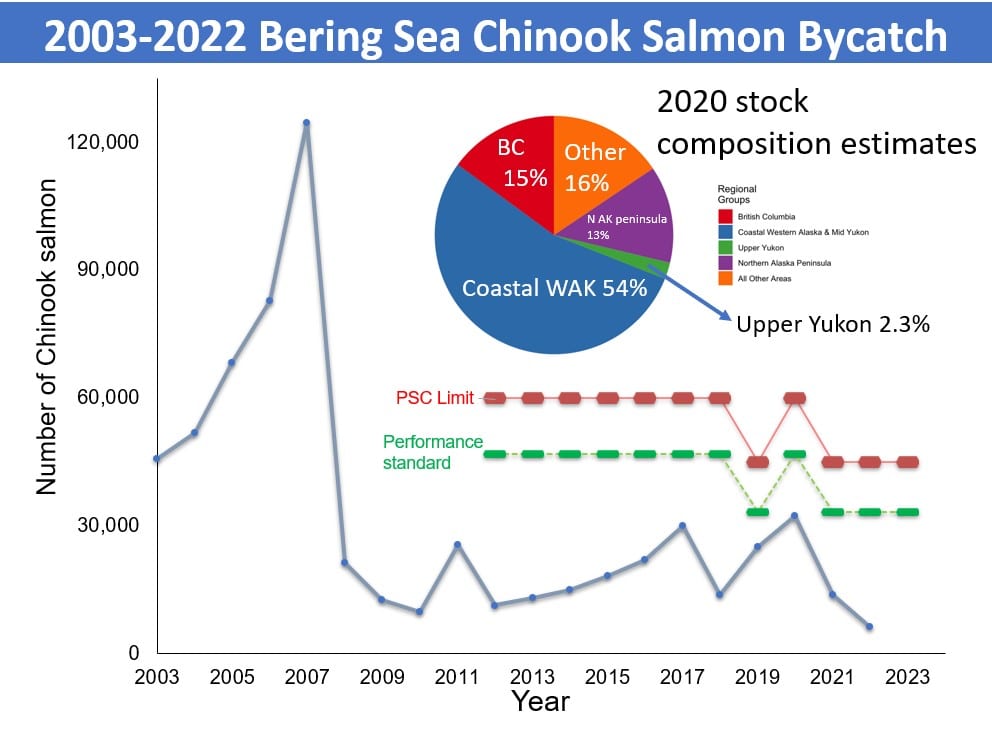
The incidental catch of salmon in groundfish fisheries is closely monitored to ensure that all salmon are counted, and representative samples are taken for genetic identification of the area of origin. Every vessel in the pollock fishery is required to have 100% observer coverage. This provides very precise count of salmon bycatch, as the observers count every salmon caught. A history of salmon bycatch and bycatch to date in 2022 in the Bering Sea groundfish fisheries is shown by the adjacent figures.
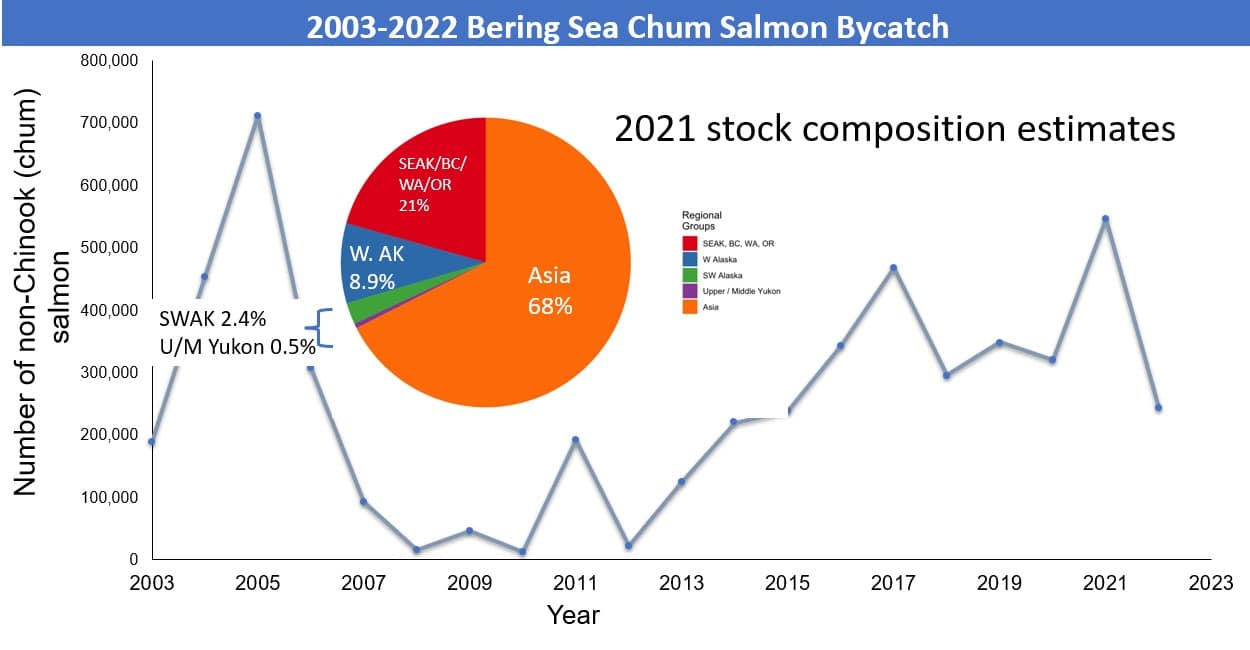
Collection of genetic information from salmon taken as bycatch also provides information on what river systems the salmon originated. For example, in 2020, 54% of the Chinook salmon bycatch was estimated to have originated from coastal western Alaska with 2.3% attributed to the middle/upper Yukon River systems. The 2021 chum salmon samples indicate that most salmon bycatch is from Asia (68% and primarily hatchery fish), with less than 1% from the middle and upper Yukon River and 8.9 from coastal western AK river systems. Annual monitoring of the bycatch indicates that the composition of the bycatch varies somewhat from year to year. Chinook salmon bycatch in the Gulf of Alaska is almost entirely composed of fish from Southeast Alaska, British Columbia and the Pacific Northwest.

Because the salmon are also measured and scale samples are taken for aging, scientists can estimate the ‘adult equivalents’ of the bycatch. That is, an estimate of how many of the bycaught salmon would have returned as adults to spawn.
By comparing the adult equivalent numbers with the run size of fish returning to the various river systems, scientists can then estimate the impacts of salmon bycatch on the runs in the different regions. In all but the highest years (e.g., 2007), Chinook salmon bycatch in the Bering Sea is less than 3 % and Chum salmon bycatch is less than 1 % of the total returns to Coastal Western Alaska Rivers.
Bycatch Management Measures
Since the mid-1990s, the Council and NMFS have developed and implemented a series of measures to minimize the incidental catch of Chinook and chum salmon in the groundfish trawl fisheries. These measures have primarily

focused on closure areas and catch limits. Experience over time showed that the industry, working cooperatively, can more effectively avoid salmon bycatch by sharing data and using a system of short term closure areas in areas where higher rates of salmon bycatch occur (for example, the adjacent figure shows the closures that were established to avoid chum salmon in 2018 for inshore catcher vessels), and using salmon bycatch excluder in pollock trawls. Recent management changes to minimize salmon bycatch are described below.
Amendment 91
In 2011, Amendment 91 established two Chinook salmon PSC limits for the pollock fishery—60,000 (total) and 47,591 (performance standard) Chinook salmon. Under Amendment 91, the PSC limit is 60,000 Chinook salmon for the entire pollock fishery fleet participating in an industry-developed contractual arrangement, called an incentive plan agreement (IPA). An IPA establishes a program to minimize bycatch at all levels of Chinook salmon abundance. The IPA provides annual reports to the Council that evaluate whether the IPA was effective at providing incentives for vessels to avoid Chinook salmon at all times while fishing for pollock. The sector-level performance standard ensures that the IPA is effective and that sectors cannot fully harvest the Chinook salmon PSC allocations under the 60,000 Chinook salmon PSC limit in most years. Each year, each sector is issued an annual threshold amount that represents that sector’s portion of 47,591 Chinook salmon. For a sector to continue to receive Chinook salmon PSC allocations under the 60,000 Chinook salmon PSC limit, that sector can only exceed its annual threshold amount 2 times within any 7 consecutive years. Under the current program, if a sector fails this performance standard, it will be allocated a portion of the 47,591 Chinook salmon PSC limit each subsequent year. This program provides the pollock fishery participants with incentives to limit Chinook salmon bycatch to the performance standard in every year, but provides the fleet with some flexibility should it encounter unanticipated changes in the fishery due to weather, operating conditions, or the status of target or bycatch species stocks.
Amendment 110
The Council developed Amendment 110 in response to multiple years of historically low Chinook salmon abundance, which resulted in significant restrictions for subsistence users in western Alaska and failure to achieve conservation objectives. While Chinook salmon bycatch impact rates had been low under Amendment 91 and had not exceeded the performance standard, the Council wanted to further minimize Chinook salmon bycatch at low levels of salmon abundance. Implemented in July 2016, Amendment 110 also incorporated chum salmon bycatch measures into the existing IPAs.
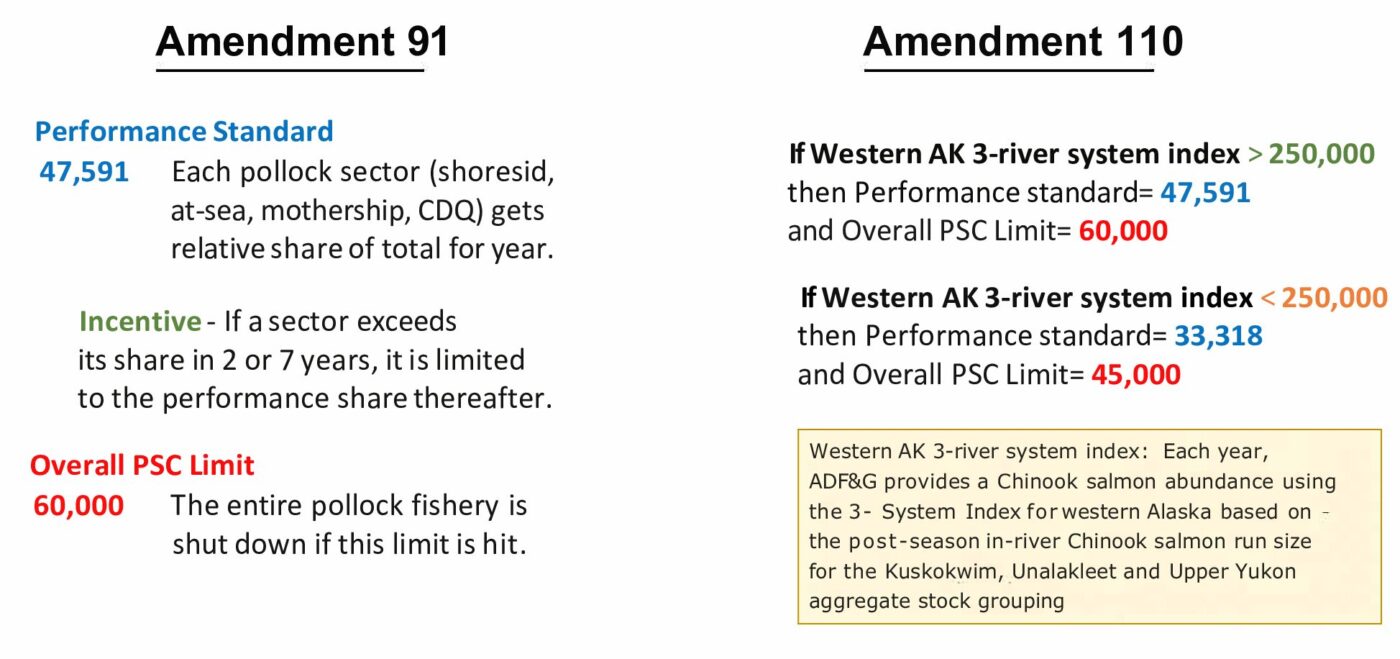
The amendment added two provisions to provide incentives to the pollock fleet to minimize Chinook salmon and chum salmon bycatch to the extent practicable. The first provision requires cooperatives to include 13 specific requirements in the IPAs to describe the measures and incentives the cooperative used to manage Chinook salmon and chum salmon bycatch. Some of these IPA requirements include incentives for the operator of each vessel to avoid Chinook salmon and chum salmon bycatch under any condition of Pollock and Chinook salmon abundance in all years; rewards for avoiding Chinook salmon, penalties for failure to avoid Chinook salmon at the vessel level or both; and an explanation of how the incentive measures in the IPA are expected to promote reductions in a vessel’s Chinook salmon and chum salmon bycatch rates relative to what might have occurred in the absence of the incentive program rewards and penalties.
The second provision of Amendment 110 added a new lower Chinook salmon performance standard and PSC limit for the pollock fishery in years of low Chinook salmon abundance in western Alaska. By October 1 of each year, the State of Alaska provides a Chinook salmon abundance using the 3-System Index for western Alaska based on the post-season in-river Chinook salmon run size for the Kuskokwim, Unalakleet, and Upper Yukon aggregate stock grouping. When this index is less than or equal to 250,000 Chinook salmon, NMFS will apply the lower performance standard and low PSC limit for the following year. In a low Chinook salmon abundance year, NMFS will set the performance standard at 33,318 Chinook salmon and the PSC limit at 45,000 Chinook salmon for the following fishing year. In 2019 there was a determination of low Chinook abundance and NMFS applied the lower PSC limit and performance standard for the 2019 fishing year. In years with no determination of a low Chinook salmon abundance, NMFS will manage under the 47,591 Chinook salmon performance standard and 60,000 Chinook salmon PSC limit. A comparison of the different PSC limits are shown in the above text boxes.
Salmon Donation Program
In 1993, the Council and NMFS established a Prohibited Species Donation Program, whereby fishermen can retain salmon and halibut PSC for distribution for hunger-relief. At this time, SeaShare is the only organization authorized to distribute this fish. SeaShare enlists fishermen, processors, and downstream service providers to efficiently handle donated fish. Funding is provided by corporations, foundations, and individuals to support the costs involved. Since inception, SeaShare has reclaimed 4.2 million pounds of fish that would otherwise have been wasted.
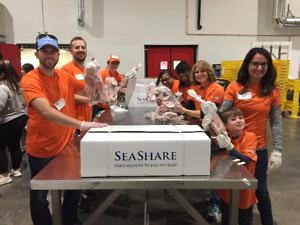
In 2019 for example, donations were received from 136 catcher boats, 38 at-sea processors, and 11 shore plants. Fishermen and processors donated their time to retain, clean and freeze the fish. SeaShare then recruited additional partners to receive, store, re-process (sort, trim, steak, glaze, pack), and ship finished products to food banks and feeding centers. Donations included 355,085 pounds of PSC salmon and 41,950 pounds of PSC halibut. Of that total, 59,700 pounds were distributed in Alaska and over 337,000 pounds outside of Alaska. Additional donations of non-PSC fish from multiple organizations were distributed within Alaska including Ling cod, sablefish and pollock. Multiple partners are solicited to distribute freight to remote communities including Lynden Air, Tote, USCG, Alaska Marine Lines and regional air taxis.
Alaska locations that received seafood from SeaShare in 2019 included: Anchorage, Kodiak, Kenai, Juneau, Nome, Cordova, Kotzebue, Fairbanks, St. Paul, Bethel, Dillingham, and other more remote locations. SeaShare works with local partners and native corporations to distribute to additional villages from Nome and Kotzebue including Diomede, Savoonga, Gambell, Wales, Deering, Buckland, Selawik, Kiana, Ambler, Kobuk, Shungnak, Noorvik, Noatak, and Kivalina.

New partnerships were also developed with the Bristol Bay Native Association, Bristol Bay Economic Development Association, Port of Dillingham, and Peter Pan Seafoods to increase food donations. The Terry Shaff Memorial Fund was created in 2014 to help increase the capacity for donations to remote villages. New in 2019, this fund was used to purchase and install freezers for food storage to allow for food distribution centers in St. Paul, Dillingham, and Bethel. In the last three years, SeaShare has donated over 630,000 pounds of fish in Alaska, equating to 2.5 million servings of high protein seafood.
Salmon Bycatch Management Programs
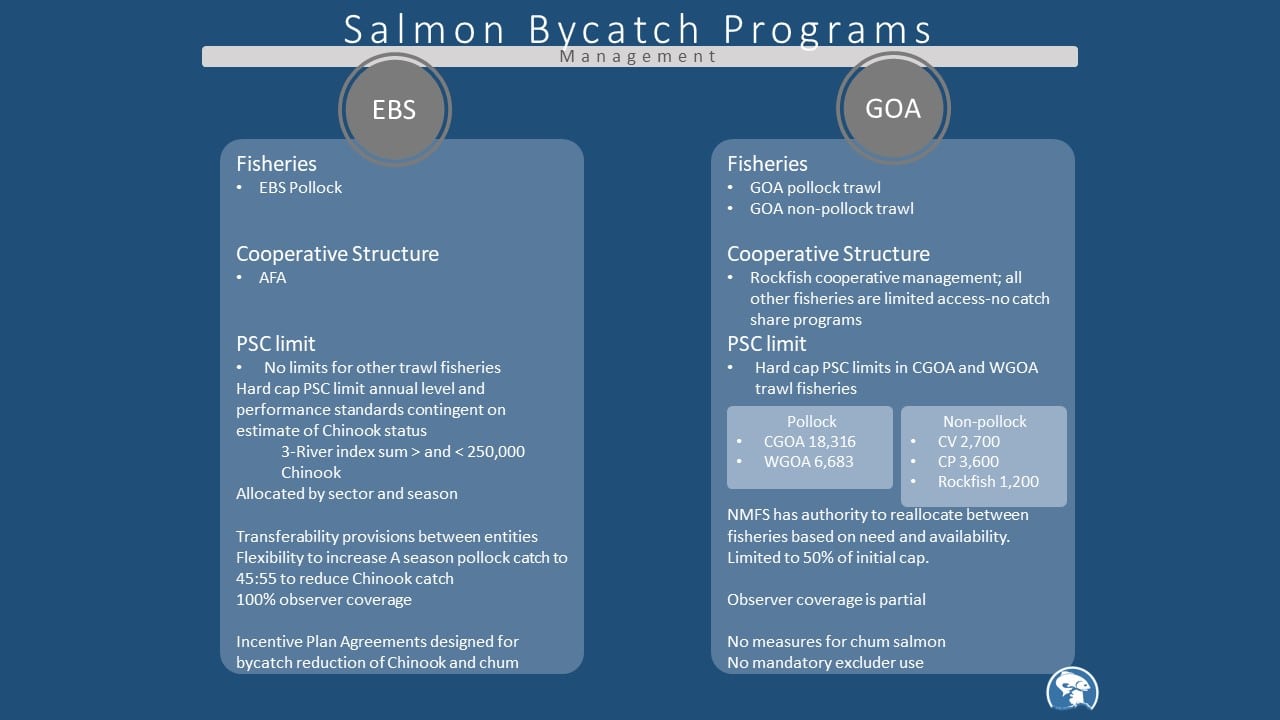
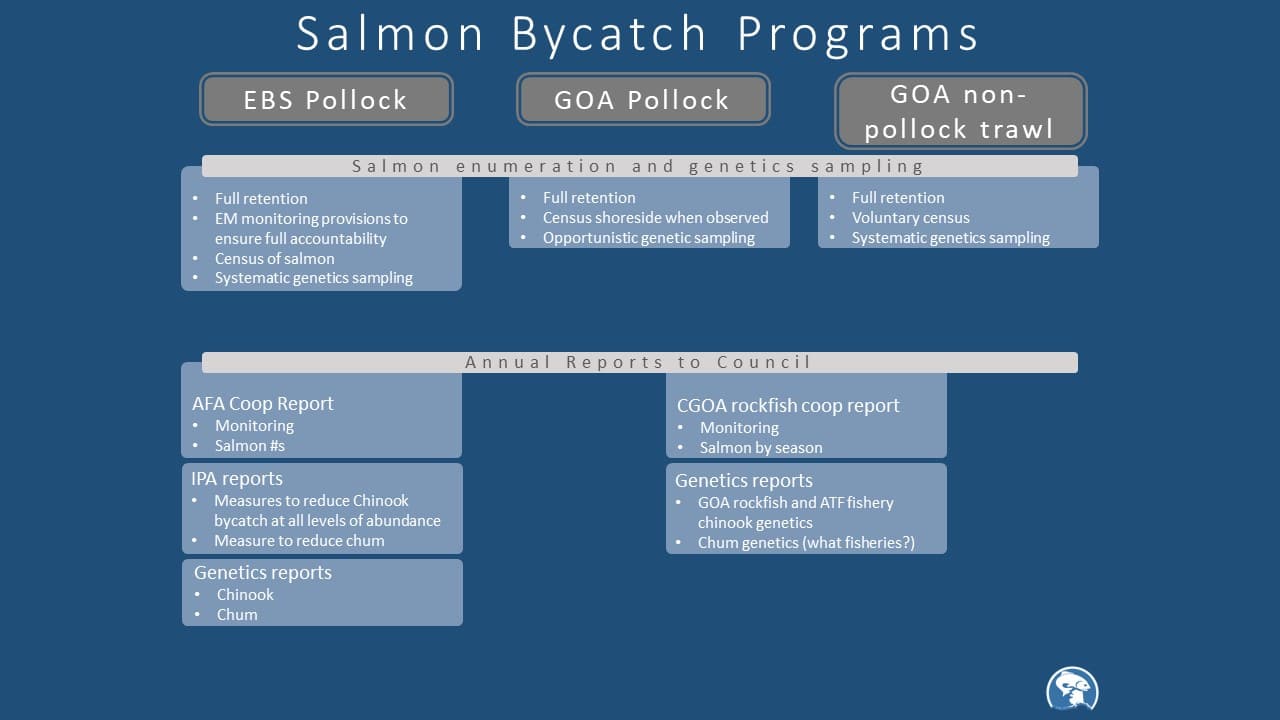
Salmon Excluder Devices
For several years, the Bering Sea pollock industry has been working on developing a Chinook salmon excluder device for trawl gear, which allows salmon to escape from the trawl net underwater while retaining pollock. The success of such devices relies on the different swimming behaviors of pollock and Chinook salmon. Through experimental fishery permits authorized by the Council and NOAA Fisheries, various iterations have been tested, and their voluntary use by pollock skippers is increasing. Recently, the GOA pollock industry has begun to consider how the Bering Sea Chinook salmon excluder might be adapted for the smaller GOA pollock fleet.
The staff contact is Diana Stram.

